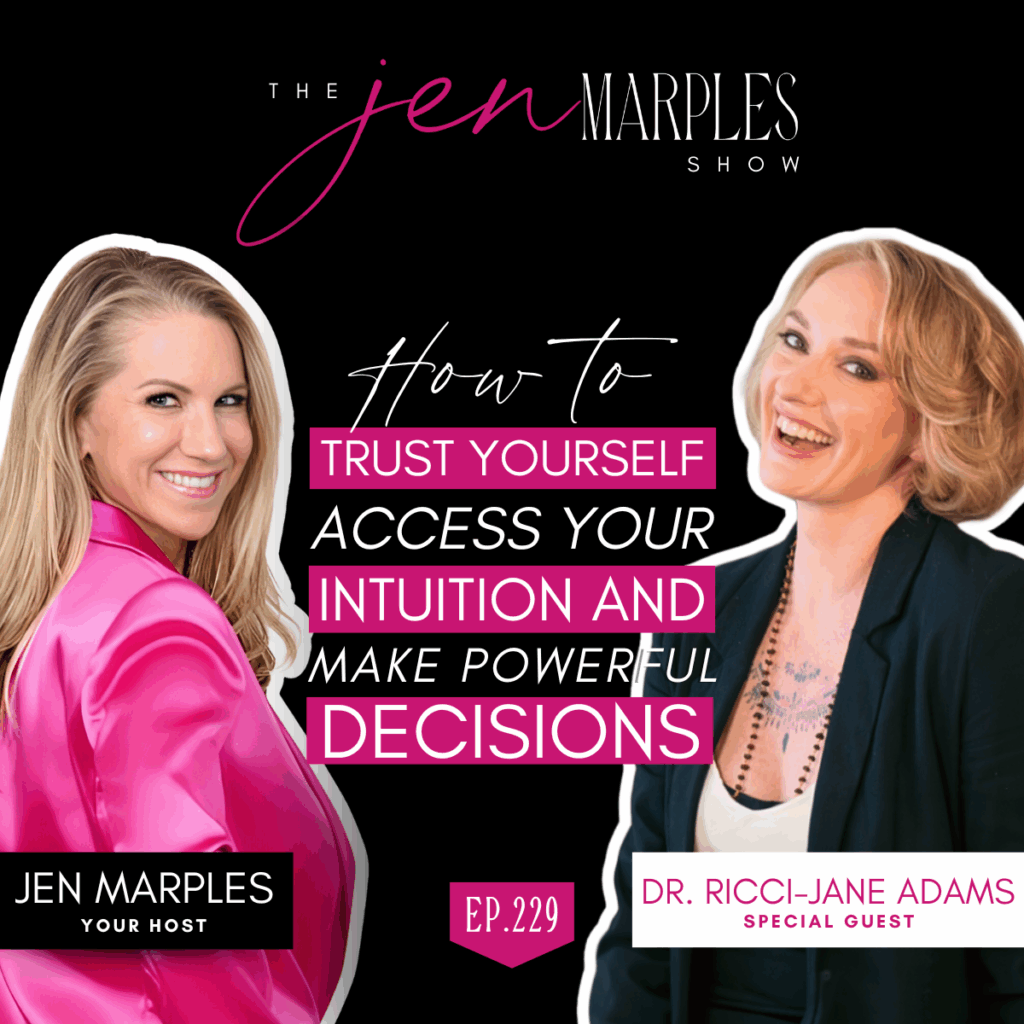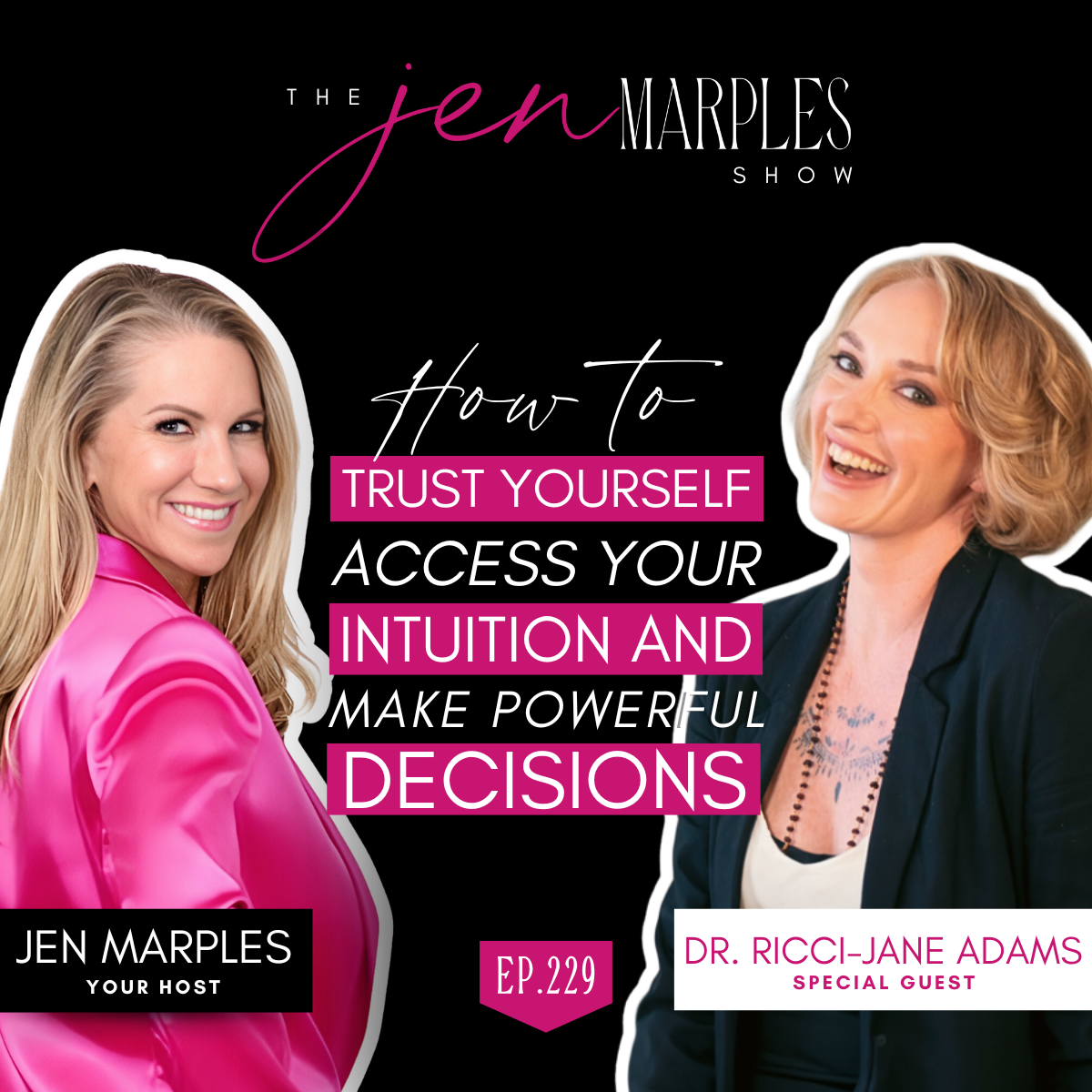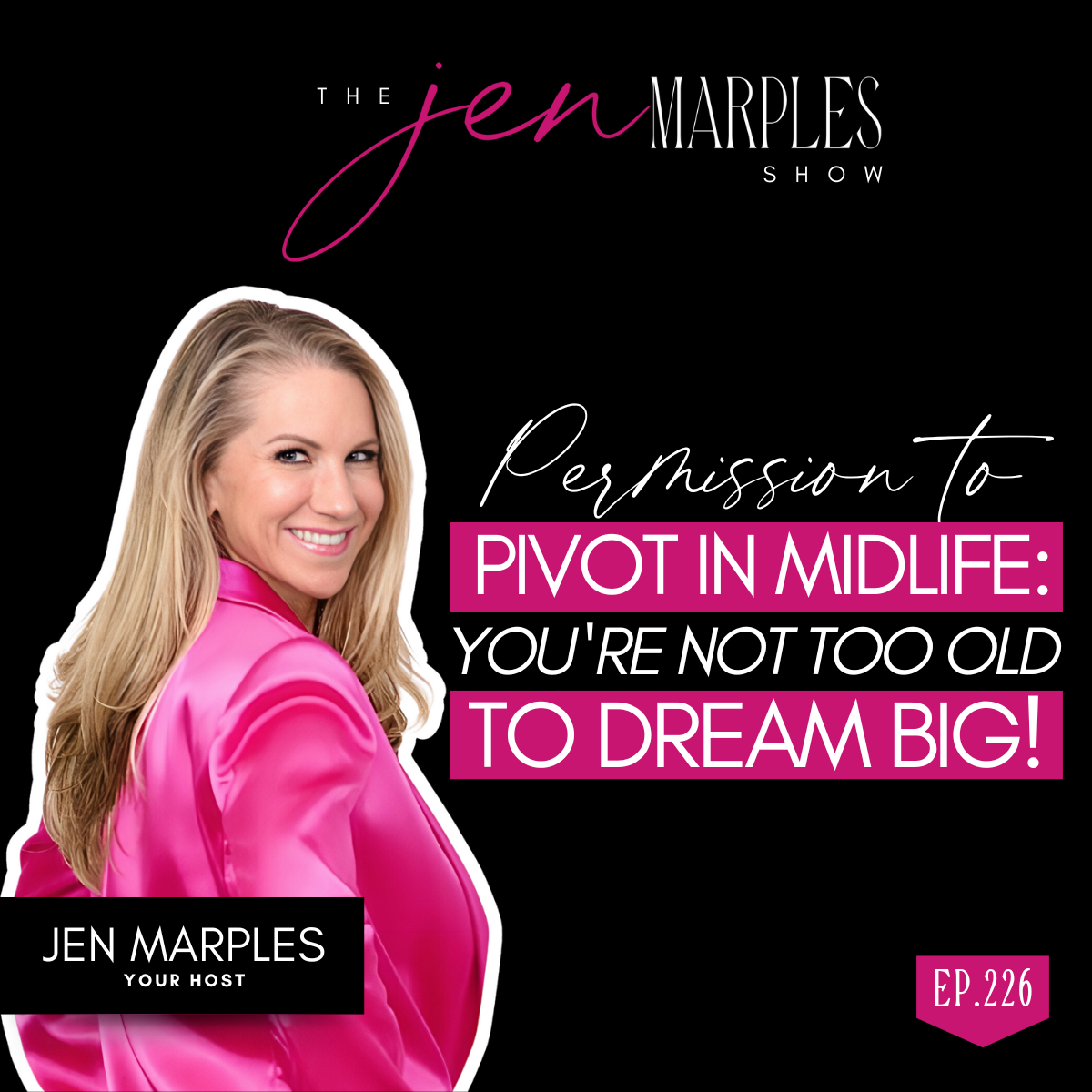
This conversation with Dr. Ricci-Jane Adams completely blew my mind, and I know it’s going to do the same for you. We’re diving deep into intuitive intelligence, which is basically intuition at its highest, most refined level. Think of it like taking that gut instinct we all have and elevating it to expert status. Ricc-Janei breaks down how to actually access that inner knowing, especially when we’re making those big midlife decisions that feel overwhelming. She’s giving us the real tools to move from gut instinct to full-blown intuitive mastery, and this is exactly what we need right now.
The truth is, we’re all running around completely dysregulated, making decisions from a place of stress and fear (guilty!), and wondering why we can’t hear our inner wisdom. Ricci-Jane explains why fear is actually intuition’s messenger and how our nervous system fitness is the key to unlocking our personal authority. This episode is packed with practical tools like the 4 S’s (stillness, silence, solitude, slowness) and her game-changing Micro Method. This is required listening, my friends!
You Need to Listen If You Want To:
- Learn how to distinguish between your intuition and trauma responses when making big decisions
- Discover the 4 S’s practice that creates nervous system fitness and opens your intuitive channels
- Understand why fear is actually your intuition’s messenger
- Master the 7-minute Micro Method that rewires your brain to release subconscious fear programs
- Give yourself permission to slow down and wait for the right time to act, even in our hustle-obsessed world
Dr. Ricci-Jane Adams Says: You’re Not Too F***ing Old! to change your mind about yourself!
Learn more about Jen Marples at https://www.jenmarples.com
Want to work with Jen? Book a complimentary 20-minute call HERE.
Follow Jen @jenmarples on Instagram, LinkedIn, TikTok and YouTube
Subscribe to Jen’s Newsletter
Unedited AI Transcript Here
CONNECT WITH GUEST:
Institute for Intuitive Intelligence
Dr. Ricci-Jane’s 7-Minute Micro Method
How to Transform Your Gut Instinct Into Your Most Powerful Decision-Making Tool
You know that feeling when you have a big decision to make and your mind goes completely blank? Or worse, you make a choice and immediately wonder if you just made a huge mistake? You’re not losing your mind. Your intuition is trying to talk to you, but there’s so much noise in the way that you can’t hear it.
This article is based on insights from Dr. Ricci Jane Adams, founder of the Institute for Intuitive Intelligence, who has spent decades studying how to transform basic gut instinct into what she calls “intuitive intelligence”—a refined, reliable form of inner guidance that helps you make better decisions, especially during life’s biggest transitions.
If you’re someone who feels overwhelmed by choices, constantly second-guesses yourself, or feels like you’ve lost touch with your inner knowing, this guide is for you. It matters because learning to access your intuitive intelligence isn’t just about making better decisions. It’s about reclaiming your personal power and learning to trust yourself again.
This guide makes sense for you if you’re tired of looking outside yourself for answers. Maybe you’ve been asking friends for advice, reading endless articles, or hoping someone else will tell you what to do. This approach works best when you’re ready to stop outsourcing your authority and start trusting yourself.
You don’t need any special gifts or abilities. Intuition is biological. Every person on the planet has it. But you do need to be willing to slow down and look at some uncomfortable things about yourself.
What You’ll Need
Here’s what will help you develop your intuitive intelligence:
- 20 minutes of uninterrupted time each day (non-negotiable)
- A quiet space where you won’t be disturbed
- Willingness to say “no” to things that drain your energy
- Patience with yourself as you learn a new skill
- A journal or notebook to track insights and patterns
- Headphones for guided meditations (optional but helpful)
You don’t need crystals, special equipment, or expensive courses. You just need commitment and consistency.
Step-by-Step Guide
Step 1: Understand the Difference Between Intuition and Intuitive Intelligence
Most people think they either “have intuition” or they don’t. They believe it’s some mystical gift that only special people possess. This is completely wrong and it keeps you stuck. The truth is that everyone has intuition—it’s that gut feeling that tells you to check on your mom or pick up your kids early even when there’s no logical reason. It’s built into your nervous system. But here’s where it gets interesting: having basic intuition is like having a lump of clay, while intuitive intelligence is like taking that clay and sculpting it into a masterpiece. You have the raw material, but you haven’t refined it yet. Most people stop at the gut instinct level and never develop it further. They dismiss their intuition as unreliable or only listen to it occasionally when it screams loud enough. Intuitive intelligence is what happens when you intentionally practice and refine that basic instinct until it becomes precise, accurate, and trustworthy. Think of it like learning a language: you might know a few words of French, but that doesn’t make you fluent. Intuitive intelligence is fluency in the language of your inner wisdom.
Step 2: Create the Right Conditions with the Four S’s
You can’t receive clear intuitive guidance when you’re stressed, rushing, or dysregulated. This is the number one mistake people make—they try to access their intuition in the middle of a crisis or when they’re overwhelmed. It doesn’t work that way. Your intuition comes through your body, and if your body is in fight-or-flight mode, the signal gets scrambled. The solution is simple but not easy: you must create what’s called “nervous system fitness” every single day. This means training your body to regulate itself efficiently so you can bounce back from stress quickly instead of spiraling for days or weeks. The four S’s are your daily practice: Stillness (your body comes to rest without distraction), Silence (no external noise or input), Solitude (nobody can demand your attention), and Slowness (you intentionally reduce your pace, breathing, and heart rate). These aren’t luxuries or nice-to-haves. They’re the foundation of everything else. Without them, you’re trying to hear a whisper in the middle of a rock concert. Most people skip this step because it seems too simple or they think they’re too busy, but this is exactly why their intuition feels unreliable.
Step 3: Learn to Recognize Fear as Intuition Speaking
Here’s where everything you thought you knew gets flipped upside down. You’ve probably been taught that fear is the opposite of intuition—that you should ignore your fear and “follow your gut” instead. This is backwards. Fear is actually your intuition trying to get your attention. When you feel afraid to make a decision or take action, your intuition isn’t broken. It’s pointing you toward an unresolved trauma, a limiting belief, or a subconscious fear program that needs to be cleared. Most people run from their fear through distraction—food, alcohol, shopping, staying busy, picking fights, or asking everyone else what to do. They spend their whole lives avoiding the discomfort. But here’s the breakthrough: fear is a messenger. It’s showing you exactly where you took on a false belief or where you experienced trauma that still lives in your body. When you have the courage to sit with your fear instead of running from it, you can ask “what’s deeper than that?” and let your body show you the real issue underneath. This is how you clear the blockage so your intuition can flow freely again. The fear isn’t the problem—avoiding the fear is what keeps you stuck and disconnected from your inner knowing.
Step 4: Use the Body-Based Practice to Rewire Your Brain
Now that you understand fear is a messenger, you need a practical tool to work with it. This is where a body-based practice becomes essential. When you’re regulated (using the Four S’s from Step 2) and you tune into a fear or uncomfortable feeling, you’re ready to do the deeper work. The process is simple: identify the feeling (maybe self-doubt, anxiety, or worry), then drop into your body and ask “what’s deeper than that?” without looking for an intellectual answer. You wait. You stay present with the discomfort. Your body might suddenly flash a memory, a word, a symbol, or a knowing—like “fear of abandonment” or “fear of not being enough.” Once you see it, you don’t push it away or try to fix it. Instead, you hold it like you would hold a scared child. You stay with it. You thank it for showing up and revealing itself to you. Then here’s the crucial part: you spend three minutes cultivating genuine gratitude for this fear, for this opportunity to know yourself better and to clear this block. What you’re doing neurologically is creating a new pathway in your brain. Instead of the old pattern (feel fear → run away → stay stuck), you’re building a new one (feel fear → sit with it → meet it with gratitude → release it). You’re literally rewiring your neural pathways through this practice. Over time, your brain will stop running from fear and will instead recognize it as valuable information.
Step 5: Distinguish Between Intuition and Trauma Response
One of the most confusing aspects of developing your intuition is knowing the difference between true intuitive guidance and a trauma response that feels like intuition. They can feel remarkably similar in your body, which is why so many people make fear-based decisions while thinking they’re following their gut. The key difference is your nervous system state. When you’re dysregulated—anxious, stressed, overwhelmed, or activated—you simply cannot access your higher intuitive intelligence. Your body is in survival mode, and survival mode doesn’t have access to the subtle wisdom of your intuition. It only has access to fight, flight, freeze, or fawn. So when you’re in that state and you “feel” like you should do something, you’re probably responding from trauma, not intuition. True intuitive intelligence comes through a regulated nervous system. It feels calm, clear, and grounded even when it’s telling you something challenging. It doesn’t have the frantic, urgent quality of a trauma response. This is why Step 2 (the Four S’s) is so critical. You must regulate first, then ask for guidance. If you try to skip the regulation step and just “trust your gut,” you’re likely to mistake a fear response for intuition and make choices that keep you stuck in old patterns.
Step 6: Build Your Self-Worth to Strengthen Your Intuition
Here’s something nobody tells you: you cannot develop intuitive intelligence without also developing self-worth. They’re completely intertwined. You might wonder what confidence has to do with intuition, but the connection is direct. When you don’t value yourself, you constantly look outside yourself for answers and validation. You ask everyone else what they think before you trust your own knowing. You override your gut feeling because someone else disagrees with you. You make choices based on what will keep other people happy instead of what’s right for you. This externalization of your authority is exactly what blocks your intuition. Intuitive intelligence requires you to trust yourself more than you trust anyone else’s opinion. It demands that you back yourself even when others disagree. It asks you to say “no” to things that don’t serve you, even when saying no disappoints people or makes them uncomfortable. And you can’t do any of that without deep self-worth. The beautiful thing is that as you practice accessing your intuition and acting on it, your self-worth grows. And as your self-worth grows, your intuition becomes clearer and more trustworthy. They feed each other in an upward spiral. But you have to be willing to start saying no, to disappoint people, to stop being available to everyone all the time, and to put yourself first—not from selfishness, but from genuine self-respect.
Step 7: Practice Consistently Without Rushing the Process
The final step is understanding that developing intuitive intelligence isn’t measured by time or a fixed timeline. You won’t “complete” this in six weeks or six months. It’s not like a certification course where you get a gold star at the end. The transformation happens through consistent intention and attention, and it can arrive in an instant or unfold over time. You might practice daily for months and then suddenly have a breakthrough moment where everything clicks. Or you might experience immediate clarity on day one. There’s no way to predict it, which means you can’t control it or force it. This is especially hard for people who like plans, timelines, and measurable results. The key is to focus on what you can control: showing up every day for your practice, saying no to things that drain you, regulating your nervous system, and sitting with your fears. The intensity of your focus matters more than the duration. Are you truly committed, or are you just dabbling? Are you willing to change your life to create space for this practice, or are you trying to squeeze it in around everything else? The real work is about stripping away all the noise and distractions in your life, not adding more techniques. It’s about what you’re willing to let go of, not what you’re willing to add.
Step 8: Honor the Uncertain Times as Sacred Initiation
There will be times when you feel completely disconnected from your intuition, even after doing all the practices. You used to have clear visions or strong knowing, and now there’s just…nothing. This is not a failure or a sign that you’re doing something wrong. In fact, it might be the most important part of your journey. When you can’t access that familiar sense of certainty, when you don’t know what you want or what’s next, you might be in what’s called a sacred initiation. You’re in the process of unbecoming old versions of yourself so something entirely new can emerge. This uncertainty isn’t a problem to solve—it’s a threshold you’re standing on. The worst thing you can do in this moment is force action or rush forward just because you’re uncomfortable with not knowing. Instead, your job is to get comfortable with the unknown. To wait. To trust that when you truly need to know something, you will know it. Your intuition will collapse from the non-physical realm into your physical awareness at exactly the right time. This requires enormous faith in yourself and in the process. It asks you to stop trying to control everything and allow something bigger to unfold. It’s the ultimate test of whether you trust your intuition—can you trust it even when it seems silent?
Conclusion
Learning to access your intuitive intelligence is not about gaining a new superpower. It’s about reclaiming something you’ve always had but learned to ignore, doubt, or override. You were born with intuition. Life taught you not to trust it. Now you’re learning to trust yourself again.
The big idea here is simple but profound: your intuition is always available, but you have to create the right conditions to hear it. You can’t access it when you’re rushing, stressed, or dysregulated. You can’t hear it when you’re avoiding your fears. And you can’t trust it when you don’t value yourself enough to act on what it tells you.
The truth is, you already know what you need to know. But you’ve been too busy, too stressed, and too afraid to listen. You’ve been outsourcing your authority to everyone else instead of trusting the wisdom that lives in your own body.
Start today. Find 20 minutes. Turn off your phone. Sit in stillness. Let yourself feel what you’ve been avoiding. Ask “what’s deeper than that?” and wait for your body to answer.
Your intuition has been trying to reach you this whole time. Now you know how to listen.




